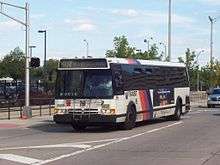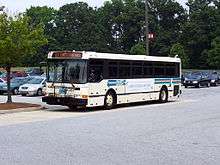Chestnut Hill West Line
| Chestnut Hill West Line | |||
|---|---|---|---|
|
An old Penn Central Silverliner at Chestnut Hill West station in May 1974. | |||
| Overview | |||
| Type | Commuter rail line | ||
| System | SEPTA Regional Rail | ||
| Status | Operating | ||
| Termini |
Chestnut Hill West Temple University | ||
| Daily ridership | 5,420[1]:94 | ||
| Website | septa.org | ||
| Operation | |||
| Operator(s) | SEPTA | ||
| Technical | |||
| Track gauge | 4 ft 8 1⁄2 in (1,435 mm) standard gauge | ||
| Electrification | Catenary | ||
| |||
The Chestnut Hill West Line is a route of the SEPTA Regional Rail (commuter rail) system. The route serves the northwestern section of Philadelphia with service to Germantown, Mount Airy, and Chestnut Hill. It is one of two commuter lines that serve these Northwest Philadelphia neighborhoods, the other being the Chestnut Hill East Line.
Route description
The Chestnut Hill West Line branches off from Amtrak's Northeast Corridor at North Philadelphia station and runs entirely within the City of Philadelphia. Its terminal is named Chestnut Hill West to distinguish it from the end of the Chestnut Hill East Line (a competing line of the Reading Company until 1976). Some stations are less than half a mile apart, a characteristic more commonly seen in an urban rapid transit system rather than a commuter rail line. The line runs roughly parallel to the Chestnut Hill East, and the two terminals are rather close.
History
The line was originally opened June 11, 1884 by the Philadelphia, Germantown and Chestnut Hill Railroad, and was operated by the Pennsylvania Railroad until 1968. Electrified service began on March 30, 1918.[2] The Penn Central operated it until 1976, turning operations over to Conrail until 1983, when SEPTA took over.
Between 1984–2010 the route was designated R8 Chestnut Hill West as part of SEPTA's diametrical reorganization of its lines. Chestnut Hill West trains operated through the city center to the Fox Chase Line.[3] Plans had called for the line to be paired with West Chester/Elwyn Line and designated R3, but this depended on a never-built connection from the Chestnut Hill West Line to the ex-Reading near Wayne Junction.[4]
Between June 26, 1987–December 17, 1989 service terminated at Allen Lane with shuttle buses serving St. Martin's, Highland and Chestnut Hill West because of unsafe conditions on the Cresheim Valley bridge. The original iron bridge dated to 1884 and was replaced with a $7.6 million steel structure financed by the Urban Mass Transportation Administration.[5]
Stations
The Chestnut Hill West makes the following station stops after leaving 30th Street Station; stations indicated with italics are closed. Weekday boardings are from FY 2013; data for North Philadelphia includes Trenton Line boardings. Italicized stations are closed/abandoned. All stations are located within Philadelphia.[1]:95–96
| Zone | Milepost | Station | Boardings | Connections |
|---|---|---|---|---|
| C | 1.9 mi (3.1 km) | Zoological Garden | ||
| 2.8 mi (4.5 km) | Engleside[note 1] | |||
| 3.2 mi (5.1 km) | Ridge Avenue[note 1] | |||
| 3.9 mi (6.3 km) | 22nd Street[note 2] | |||
| 1 | ||||
| 4.7 mi (7.6 km) | North Philadelphia | 184 | ||
| 5.5 mi (8.9 km) | Westmoreland[note 3] | |||
| 6.8 mi (10.9 km) | Queen Lane | 521 | ||
| 7.4 mi (11.9 km) | Chelten Avenue | 324 | ||
| 2 | 7.9 mi (12.7 km) | Tulpehocken | 171 | |
| 8.4 mi (13.5 km) | Upsal | 440 | ||
| 9.0 mi (14.5 km) | Carpenter | 401 | ||
| 9.4 mi (15.1 km) | Allen Lane | 289 | ||
| 10.2 mi (16.4 km) | St. Martins | 241 | ||
| 10.7 mi (17.2 km) | Highland | 51 | ||
| 11.3 mi (18.2 km) | Chestnut Hill West | 433 | ||
Ridership
Yearly ridership on the Chestnut Hill West Line between FY 2008–FY 2014 has remained steady around 1.5–1.6 million:[1]:94[7][8][9][10][11][12]
Notes
References
- 1 2 3 "Fiscal Year 2016 Annual Service Plan" (PDF). SEPTA. June 2015. Retrieved August 13, 2016.
- ↑ Williams, Gerry (1998). Trains, Trolleys & Transit: A Guide to Philadelphia Area Rail Transit. Piscataway, NJ: Railpace Company. p. 95. ISBN 978-0-9621541-7-1. OCLC 43543368.
- ↑ Lustig, David (November 2010). "SEPTA makeover". Trains Magazine. Kalmbach Publishing: 26.
- ↑ Vuchic, Vukan; Kikuchi, Shinya (1984). General Operations Plan for the SEPTA Regional High Speed System. Philadelphia: SEPTA. pp. 2–8.
- ↑ Hollman, Laurie (December 17, 1989). "A Bridge Is Rebuilt With Clout". The Philadelphia Inquirer. Retrieved August 13, 2016.
- ↑ Dougherty, Frank (September 23, 1994). "Early Figures Show Boost for Transit". Philadelphia Daily News.
- ↑ "Fiscal Year 2015 Annual Service Plan" (PDF). SEPTA. May 2014. p. 60. Retrieved August 13, 2016.
- ↑ "Fiscal Year 2014 Annual Service Plan" (PDF). SEPTA. May 2013. p. 44. Retrieved August 13, 2016.
- ↑ "Fiscal Year 2013 Annual Service Plan" (PDF). SEPTA. May 2012. p. 55. Retrieved August 13, 2016.
- ↑ "Fiscal Year 2012 Annual Service Plan" (PDF). SEPTA. July 2011. p. 94. Retrieved August 13, 2016.
- ↑ "Fiscal Year 2011 Annual Service Plan" (PDF). SEPTA. June 2010. p. 70. Retrieved August 13, 2016.
- ↑ "FY 2010 Annual Service Plan" (PDF). SEPTA. June 2009. p. 63. Retrieved August 13, 2016.
_TRAIN_ROUTE_IN_THE_SUBURBS_OF..._-_NARA_-_556772.jpg)




